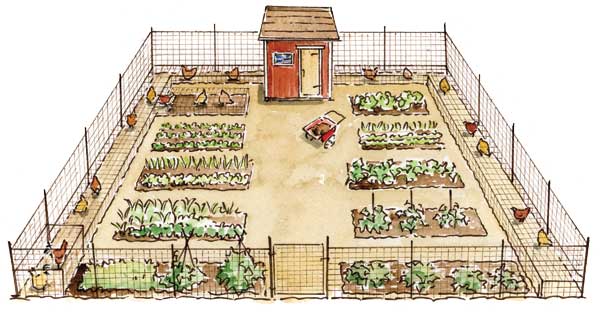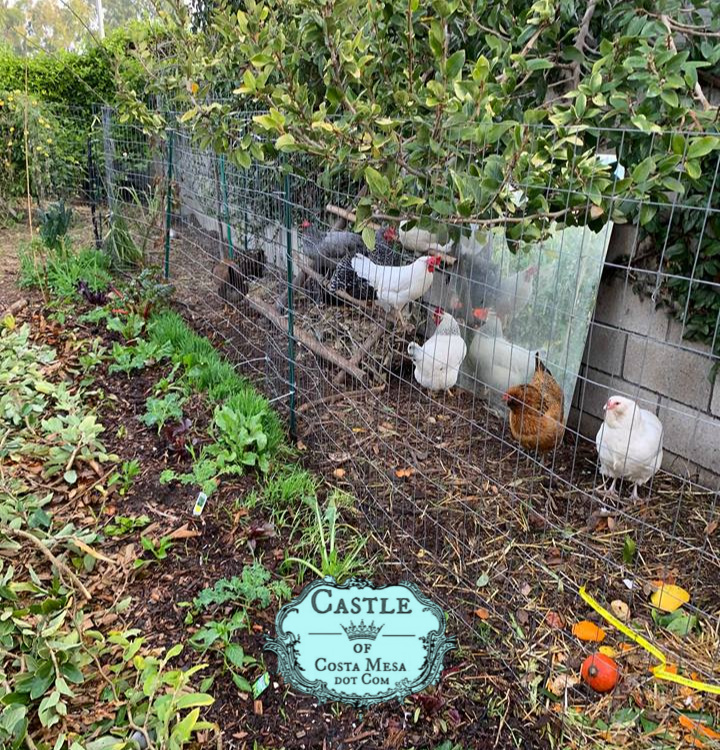I want the company and music of chickens. I also want to grow heirloom tomatoes and other foods in my backyard. How do I create a happy chicken and vegetable garden coexistence? After much pondering, I offer you my happy results: Our Chicken Moat Self-feeding Fodder System!
This page is unfinished because I need to go chat with the chickens.
You can follow us on Instagram: @CastleofCostaMesa
Feel free to support our endeavors by buy a poster or some handmade goodies from our Castle of Costa Mesa Etsy shop. Thank you!
We love our chickens. We let them have the run of our beautiful vegetable garden in the back yard. By winter 2018. This was what our vegetable garden looked like…
January 17, 2018. Chicken took over my vegetable garden!
Vegetable garden? What vegetable? They ate up every shred of vegetation!
I love the company of chickens when I work in the garden. Yet, if I let them run free, they would devour all my plants.
I created a chicken moat to surround my garden. This allowed the chickens to keep me company as I work in the garden, yet it protects the roots of my plants from being scratched and plants being destroyed by chickens.
Here were my goals in designing my chicken moat fodder system
- protect my plants from being killed by chickens
- Instead of locking up my chickens in the coop area in the back, this moat system allows my chickens to free-range and to be with me in the garden yet not in the garden beds
- I want this to be as similar to a forest as possible for my woodland birds
- I want the system to generate rich soil for my food forest garden
- I want the chickens to be able to forage for foods with this ecosystem: Fruits, leaves, grains, sprouts, june bug grubs and other garden bugs as natural fodders.
- a real and peaceful, quality life for my free ranging hens
- an area for us to sit with the hens
- easy harvesting of compost
- easy addding of leaves and other composting materials to the chickens.
Chicken Moat
Diagram of a chicken moat. Chickens to keep you company, protect your garden from bugs, eat up your garden wastes, fences will protect your garden from the devouring chicken forces.
Source: Mother Earth News. Illustration By Elayne Sears
Chickens in the surrounding perimeter of the garden. It is easy to drop off leaves and other foods for the chickens when they are so close around.
The more length of the chicken run, the more area to grow fodders on or along the fences for the hens to self-serve their meals.
< sketch: my chicken moat based on our garden. Dropping fruits mulberries, passionfruit forest, coop, fodder system, chards, sun gold tomato, raspberry >
Gateway to Chicken Moat
Photo above: South entrance gate to the chicken moat. January 7, 2020.
Nunu chopped down the front yard moringa tree trunks to allow sunshine into the front yard. She then harvested the trunks to make gates for the chicken moat/run (above).
June 16, 2018. Vihren feeding the chickens. Sweet delicious kabocha squash grows vigorously up the cattle panel trellis framing the chicken moat gate. It is nice to have an open area along the moat for the children to sit, relax and hand feed the chickens.
The chicken moat/chicken run is also my composting site. We feed the chickens kitchen scraps, leaves from the garden, grains and so forth. We also cover the run with leaves and other carbon sources to help create a compost-friendly environment. Periodically we water the run to encourage soil life such as earthworms.
January 31, 2019. View towards north. Fresh leaves in the chicken run. It’s like Christmas for chickens. They love to dig in the fresh leaves!
January 31, 2019. View south. Chickens happily digging in the leaf mulch!
In-Ground Chicken’s Salad Bar
Goal: I wanted to grow fresh, nutritious fodder for my hens, plus, I want them to be independent foragers. This is a beautiful solution for my quest!
Originally, I considered sprouting grains in buckets for the hens to eat, but mold would set in and bleach had to be brought in to prevent mold. I do not like my hens to eat bleach routinely. So, I decided to grow directly in the soil to bypass this mold problem.
Here is how: I buy organic grains from the bulk bins of the grocery store. I soak the grains overnight, or longer as needed for sprouting to occur.
Next, I dig a shallow trench, plant the sprouted grains in the trench and cover the grains with dirt. I water it and watch the fodder grow green and lush in the ground.
Using horse wire mesh, T-post and and zip ties, my daughter and I set up a “moat” systen of chicken run to surround our heirloom tomato and vegetable garden. The key feature of this fence is the mesh deters the hens from entering my vegetable garden, yet the holes are large enough for the hens to reach over to eat the living plants, grown along the fence.
Photo: Chicken salad bar. Whenever Irena wants to, she could just stick her head out the wire and feast upon fresh wheat sprouts!
Growing food along the chicken run. The closest plants (usually grains like wheat, barley, rye, etc) are for feeding the hens. The next furthest away are leafy greens such as chard, kale, beets, etc to feed the hens on one end and to feed our family on the other end.
The furthest away are crops solely for our family’s consumption, such as onions or alpine strawberries.
We also grow foods needing supporting trellising structure of the fence to grow. Such foods feed the hens on one side and our family on the other side. Examples: thornless Triple Crown Blackberry, raspberries, Sungold, Black Cherry and other prolific tomatoes.
February 24, 2019. Elizabeth Warren sticking her head out of the wire fence to take a big bite of fresh wheat sprout growing along the chicken run.
January 31, 2019. Anna Magdalena Bach taking a big chomp on the fresh green wheat sprout across the chicken run wire fencing.
February 24, 2019. Madame Kokoshka Walnut contemplating taking a bite of the fresh green fodder. The fodder growing closer to the run gets eaten short. The fodder growing further away escapes the fate. My hope is that the farther fodder (in this case, wheat sprout) will escape being eaten so they reach maturity and drop seed, to naturally sow the next cycle of fodder for the chickens.
March 14, 2020. My children planted Mara des Bois alpine strawberries along the chicken run, out-of-reach of the hens, for my birthday.
My girl and I built the chicken moat fencing in less than one morning’s time.
wire, T-post, zip ties, fence banger
The height of my fence. Clipping wings. Coyotes, crows, predators.
Passion Fruit Forest – for Chicken Privacy and Escape from Hot Sun
Zulaykha (Zuzu) in the passion fruit forest nest.
As much as I love to be surrounded by chickens all day long, I feel the need to respect their need of privacy. So, the northern leg of the chicken moat is a forest tunnel. It is basically the same fencing system with overgrown passionfruit vines covering the top and so thick that the hens get refuge from hot summer sun, overhead predators such as hawks and prying eyes of humans.
May 18, 2018. Vihren harvesting eggs in the North chicken run, aka passion fruit chicken forest.
Towards the No-Feed Chicken System
My dream is to design my backyard ecosystem to feed my family and allow my hens to naturally be feed by dropping fruits and other live plants in their environment.
I strategically plant fruit trees that can feed my hens sequentially through the seasons:
- King Shatoot mulberry in late spring
- Peaches in summer
- Cherry tomatoes in summer
- Grapes and june bug grubs that eat my grapes in fall
- Grain fodders – year round
- Leafy greens – year round
My Chicken Moat/Chicken Run is An Organic Compost Generating Machine
March 6, 2020. Vihren harvesting rich, black, earthworm-filled compost for our garden beds. We are growing heirloom tomatoes, roses, fruit trees, salad patch, et cetera for our edible garden.
March 9, 2019. Our salad patch, grown with organic compost generated from my own garden.
You can follow us on Instagram: @CastleofCostaMesa
Feel free to support our endeavors by buy a poster or some handmade goodies from our Castle of Costa Mesa Etsy shop. Thank you!
Click here to see our active decay cycle composting chicken coop.




















